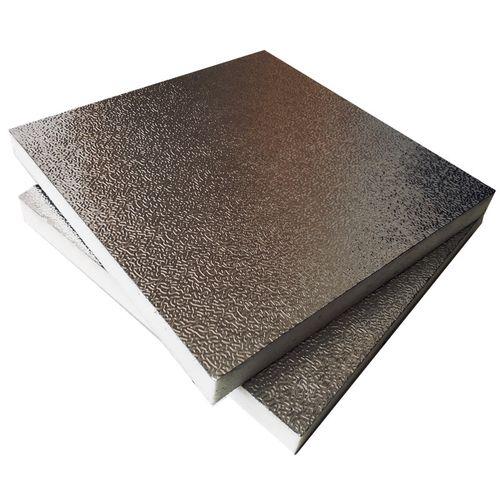Coated aluminum foil for polyurethane foam board is a specially designed aluminum foil. As the surface material of polyurethane foam board, it is mainly used in the application of construction, thermal insulation and heat preservation materials. It combines the excellent properties of aluminum foil and the additional properties of coating materials, which can improve the overall performance and durability of polyurethane foam board. It is combined with foam core material through composite process, and has both the physical properties of aluminum foil and the functional properties of coating.
Thickness
The aluminum foil substrate thickness of coated aluminum foil used for polyurethane foam board is usually between 0.025mm (25μm) and 0.08mm (80μm), and the most commonly used specifications are 0.03mm~0.06mm (30~60μm). The thickness selection needs to balance performance and cost: too thin (<20μm) is easy to break during processing or use, affecting the barrier property; too thick (>80μm) will increase the weight and cost of the material, and the flexibility will decrease, which is not conducive to composite processing.

Coating
Coating is the core of improving the function of aluminum foil. According to the application scenario (such as indoor/outdoor, weather resistance requirements, etc.),
– Epoxy coating: mainly used to enhance the adhesion between aluminum foil and adhesive, usually as a bottom coating, combined with PE or PVDF coating (such as “epoxy bottom + PVDF surface” double-layer coating structure).
The coating thickness is generally 5μm~30μm. PVDF coating is usually thicker (15~30μm) due to weather resistance requirements, and PE coating is thinner (5~15μm).
Surface
The surface can be embossed or smoothed according to needs, with embossed aluminum foil for insulation board as the mainstream:
– Embossing treatment: Fine lines (such as hairline lines), orange peel lines, diamond lines and other patterns are rolled out by a rolling mill. The functions are:
① Enhance the surface scratch resistance and wear resistance;
② Reduce light reflection (avoid light pollution);
③ Improve the bonding strength with adhesives (patterns increase contact area);
④ Hide tiny scratches and improve aesthetics.
– Smooth surface: suitable for scenes with high requirements for surface flatness (such as mirror effect requirements), but with weak scratch resistance and less application.
Typical structure of polyurethane foam board
The composite structure of coated aluminum foil and polyurethane foam board is usually a “sandwich” sandwich structure, from outside to inside:
[Coated aluminum foil layer] → [Adhesive layer] → [Polyurethane foam core] → [Adhesive layer] → [Coated aluminum foil layer]
– Coated aluminum foil layer: The outer layer is a coating, and the inner layer is an aluminum foil substrate, which provides protection, barrier and decoration functions;
– Adhesive layer: Usually polyurethane glue or hot melt glue, to ensure that the aluminum foil and the foam core are firmly bonded;
– Polyurethane foam core: High-density (40~60kg/m³) hard foam, providing insulation and support.
Core advantages of coated aluminum foil for polyurethane foam board:
– Excellent thermal insulation:
The thermal conductivity of polyurethane foam is extremely low (≤0.022W/(m·K)), and the high reflectivity of aluminum foil (reflecting more than 80% of infrared radiation) greatly reduces heat transfer;
– Super moisture and water resistance:
Aluminum foil is an excellent water vapor barrier (water vapor permeability is close to 0), and the coating further enhances water resistance to prevent the foam from absorbing moisture and failing;
– Excellent weather resistance:
Coatings are resistant to UV aging and acid and alkali corrosion, and can adapt to extreme outdoor environments of -40℃~80℃, with a service life of more than 20 years;
– Lightweight and high strength:
The density of the composite board is only 30~80kg/m³, but the strength can meet the requirements of wind pressure and impact resistance of the building, reducing the structural load;
– Beautiful and easy to maintain:
The coating can be customized in a variety of colors (such as white, gray, metallic), the surface is easy to clean, and the appearance remains neat for a long time;
– Convenient construction:
The board size is stable (length 2~6m, width 0.9~1.2m), and it can be directly cut and installed to shorten the construction period.
Main application areas of coated aluminum foil polyurethane foam board:
– Building insulation:
External wall insulation system, roof insulation layer, household wall insulation (especially suitable for cold areas or energy-saving buildings);
– Low temperature insulation:
Cold storage, cold storage, quick freezing workshop (need to maintain low temperature for a long time, aluminum foil moisture-proof + polyurethane insulation double protection);
– Mobile insulation:
Refrigerated trucks, container insulation box (lightweight and vibration-resistant);
– Clean and special environment:
Electronic clean workshop, food workshop (smooth surface, easy to clean, anti-mildew);
– Industrial insulation:
Pipeline insulation, equipment shell insulation (reduce energy loss).
In summary, the coated aluminum foil for polyurethane foam boards is a perfect combination of “functional surface layer + high-efficiency thermal insulation core”. Its performance can be customized through the design of aluminum foil thickness, coating type, and surface treatment to meet the core needs of different scenarios (such as weather resistance, heat insulation, aesthetics, etc.). It has irreplaceable advantages in the field of thermal insulation and energy saving.
